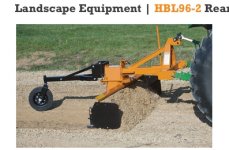HCJtractor
Veteran Member
- Joined
- Jan 28, 2009
- Messages
- 1,544
- Location
- upstate South Carolina, Greenville
- Tractor
- Kubota M6800, Massey Ferguson 240
Just bought an 8' Gill rear blade, heavy duty, weighing in at 600 lbs. I'll pull it with my 65 horse Kubota. It has no hydraulics, but I do have a hydraulic top link that can be used. I've used a box blade a lot, but never a rear scrape blade. I plan to use it to maintain the dirt roads on my property, which is kinda rough. Lots of rolling hills, turns, clay, some rock but not bad, water drainage issues etc. my goal is to keep the roads reasonably smooth, try to control the runoff to minimize gullies that form, and to repair existing washed areas.
I realize a fully hydraulic blade would be nice, but that's not what I have. My question is since I have one remote on the rear, would I be better off using it somewhere other than the top link? I guess I could put a cylinder on the offset linkage instead, but that doesn't seem like it helps much. Better yet, I can see how have hydraulic control over the horizontal tilt would be nice, but I would have to modify my blade . I'm looking for tips on using this blade . Is there a sequence to how I should begin, as far as setting the blade position and where to begin on the road? Today I used it for the first time just dragging it around with all settings at neutral. I suppose there's a better way. Any tips would be appreciated.
Sent from my iPad using TractorByNet
I realize a fully hydraulic blade would be nice, but that's not what I have. My question is since I have one remote on the rear, would I be better off using it somewhere other than the top link? I guess I could put a cylinder on the offset linkage instead, but that doesn't seem like it helps much. Better yet, I can see how have hydraulic control over the horizontal tilt would be nice, but I would have to modify my blade . I'm looking for tips on using this blade . Is there a sequence to how I should begin, as far as setting the blade position and where to begin on the road? Today I used it for the first time just dragging it around with all settings at neutral. I suppose there's a better way. Any tips would be appreciated.
Sent from my iPad using TractorByNet

